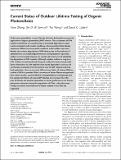Files in this item
Current status of outdoor lifetime testing of organic photovoltaics
Item metadata
| dc.contributor.author | Zhang, Yiwei | |
| dc.contributor.author | Samuel, Ifor D. W. | |
| dc.contributor.author | Wang, Tao | |
| dc.contributor.author | Lidzey, David G. | |
| dc.date.accessioned | 2018-06-11T08:30:06Z | |
| dc.date.available | 2018-06-11T08:30:06Z | |
| dc.date.issued | 2018-08 | |
| dc.identifier | 253025527 | |
| dc.identifier | 566cbd24-ac6a-4810-8aa7-8ffaad206b83 | |
| dc.identifier | 85051481407 | |
| dc.identifier | 000441869400014 | |
| dc.identifier.citation | Zhang , Y , Samuel , I D W , Wang , T & Lidzey , D G 2018 , ' Current status of outdoor lifetime testing of organic photovoltaics ' , Advanced Science , vol. 5 , no. 8 , 1800434 . https://doi.org/10.1002/advs.201800434 | en |
| dc.identifier.issn | 2198-3844 | |
| dc.identifier.uri | https://hdl.handle.net/10023/13877 | |
| dc.description | I.D.W.S acknowledges support from the EPSRC (grant EP/L012294/1) and a Royal Society Wolfson Research Merit Award. | en |
| dc.description.abstract | Performance degradation is one of the key obstacles limiting the commercial application of organic photovoltaic (OPV) devices. The assessment of OPV stability and lifetime are usually based on simulated degradation experiments conducted under indoor conditions, whereas photovoltaic devices experience different environmental conditions under outdoor operation. Besides the intrinsic degradation of OPV devices due to the evolution of optoelectronic and morphological structure during long‐term operation, outdoor environmental changes can impose extra stresses and accelerate the degradation of OPV modules. Although outdoor studies on long‐term OPV stability are restricted by the long data collection times, they provide direct information on OPV stability under mixed degradation stresses and are therefore invaluable from the point of view of both research and practical application. Here, an overview of the current status of outdoor lifetime studies of OPVs is provided. After a summary of device lifetime extrapolated from indoor studies, outdoor lifetime testing platforms are introduced and the operational lifetime of various OPV devices are reviewed. The influence of climate and weather parameters on device performance and burn‐in phenomena observed during the degradation of OPVs is then discussed. Finally, an outlook and directions for future research in this field are suggested. | |
| dc.format.extent | 17 | |
| dc.format.extent | 3483008 | |
| dc.language.iso | eng | |
| dc.relation.ispartof | Advanced Science | en |
| dc.subject | Lifetime | en |
| dc.subject | Organic photovoltaics | en |
| dc.subject | Outdoor | en |
| dc.subject | Stability | en |
| dc.subject | Test protocols | en |
| dc.subject | QC Physics | en |
| dc.subject | TK Electrical engineering. Electronics Nuclear engineering | en |
| dc.subject | T-NDAS | en |
| dc.subject | SDG 7 - Affordable and Clean Energy | en |
| dc.subject.lcc | QC | en |
| dc.subject.lcc | TK | en |
| dc.title | Current status of outdoor lifetime testing of organic photovoltaics | en |
| dc.type | Journal item | en |
| dc.contributor.sponsor | EPSRC | en |
| dc.contributor.sponsor | The Royal Society | en |
| dc.contributor.institution | University of St Andrews. School of Physics and Astronomy | en |
| dc.contributor.institution | University of St Andrews. Condensed Matter Physics | en |
| dc.identifier.doi | 10.1002/advs.201800434 | |
| dc.description.status | Peer reviewed | en |
| dc.identifier.grantnumber | EP/L012294/1 | en |
| dc.identifier.grantnumber | en |
This item appears in the following Collection(s)
Items in the St Andrews Research Repository are protected by copyright, with all rights reserved, unless otherwise indicated.

